|
|
EUGENE M. MCCARTHY, PHD
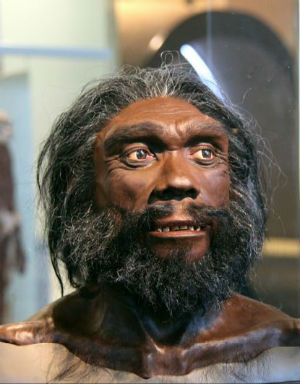
|
|
Homo heidelbergensis reconstruction (Enlarge) The Hall of Human Origins, Smithsonian. Image: Tim Evanson |
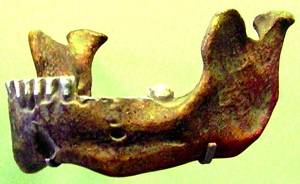
|
| Mauer Jaw |
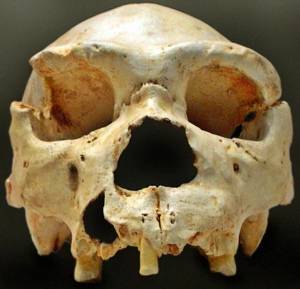
|
| Cranium 5 from Sima de los Huesos cave, Atapuerca, Spain, one the best preserved ancient hominid skulls ever found. Image: José-Manuel Benito |
In 1907, two workmen digging in a commercial sandpit near the village of Mauer, not far from Heidelberg, Germany, found a human-like jaw that was too robust to be that of a modern human being. It had a receding chin and most of the teeth — which are rather small given the size of the jaw — were intact (for a better view of the teeth, click on the picture of the jaw at left below).
This sturdy mandible was soon famed as the Mauer Jaw. Otto Schötensack (1908), who wrote a formal description of the specimen, treated its former owner as a species distinct from previously known forms. He named this early type of human being Homo heidelbergensis ("Heidelberg man"). The exact age of the Mauer Jaw is unknown, but it is thought to be between 400,000 and 700,000 years old.
However, the great majority of remains attributed (tentatively) to Homo heidelbergensis have been obtained recently, beginning in 1997, in the Sima de los Huesos cave at Atapuerca in northern Spain, where bones from some thirty separate individuals have been recovered. The material dates to about 400,000 years B.P.
There is a thick deposit of bones in the cave, where animals fell in and their remains built up over time (sima is Spanish for chasm or abyss; huesos means bones). Nearly all of the bones were shattered by the long fall, but it has often proved possible to find and reassemble the pieces.
The fact that the human remains are all those of teenagers or young adults, has led researchers to speculate they were sacrificial victims, intentionally hurled into the abyss (since the expectation otherwise would be to find individuals of a variety of ages).
Included in the recovered material is the spectacularly well-preserved Cranium 5 (pictured at right). The same site has yielded other nearly intact specimens — notably, the well-known pelvis "Elvis". The oldest human remains found on European soil are those from the nearby Sima del Elefante ("Chasm of the Elephant"), which date to 1.1–1.2 mya (Carbonell et al. 2008). But these have not been assigned to heidelbergensis. Well-dated remains attributed to Homo heidelbergensis range from 600,000 to 350,000 years in age, considerably older than the material assigned to Germany's other, more famous caveman, Homo neanderthalensis.
Some facts about Homo heidelbergensis
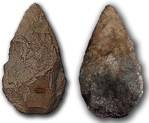
|
|
Quartzite biface from Atapuerca (Enlarge) |
No artwork or other sophisticated productions have been found in association with Homo heidelbergensis, only stone tools similar to those used by Homo erectus (Acheulean bifaces). And, although there has been much speculation on the subject, it is unknown whether this — or any other hominid prior to Homo sapiens — could speak.
Available specimens of H. heidelbergensis indicate this hominid stood about six feet (1.8 m) tall and was more robust than the typical human today. Its cranial capacity (~1250 cc) was about 93 percent of the average for Homo sapiens (~1350 cc) — well within the range of variation for modern humans.
The status of Homo heidelbergensis as a distinct type of hominid is controversial. Many researchers maintain the facts disallow any clear distinction between Homo erectus and early Homo sapiens. They say that heidelbergensis is simply a name imposed by humans on fossils that should be regarded as transitional and that specimens assigned this name should in fact be regarded as either "late Homo erectus" or "archaic Homo sapiens."
Perhaps we are not from the apes alone?
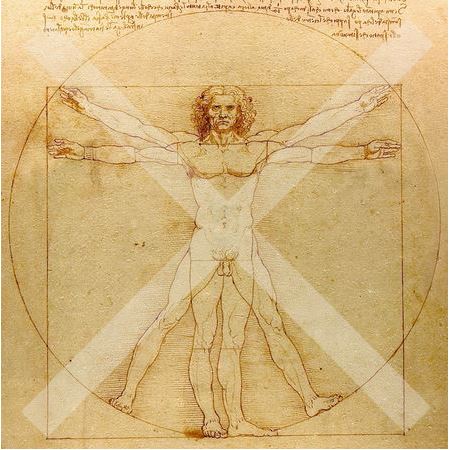
|
|
Etymology: The name of this hominid is constructed from the name of the city Heidelberg, the Latin suffix -ensis, and the Latin word homo meaning human or man. |
More hominids:
Australopithecus bahrelghazali >>
Most shared on Macroevolution.net:
Human Origins: Are we hybrids?
On the Origins of New Forms of Life
Mammalian Hybrids
Cat-rabbit Hybrids: Fact or fiction?
Famous Biologists
Dog-cow Hybrids
Georges Cuvier: A Biography
Prothero: A Rebuttal
Branches of Biology
Dog-fox Hybrids